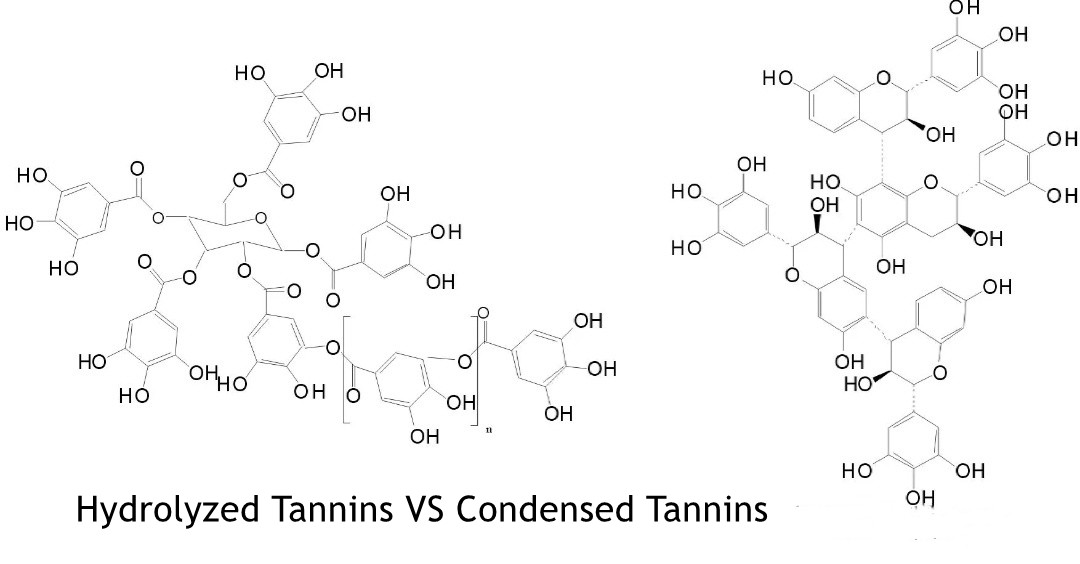Hydrolyzed Tannins VS Condensed Tannins
Tannins are a group of naturally-occurring compounds that are widely distributed in the plant kingdom, ranging from seeds to fruits. They are known for their astringency and bitterness, and are found in many fruits, vegetables, nuts, and seeds, as well as in bark, leaves, and wood of various plants. Tannins have been used for centuries in traditional medicine and in the production of dyes, inks, and adhesives. They are also used as a natural preservative in food and beverages, as well as in cosmetics and other personal care products.
There are two main types of tannins: hydrolyzable tannins and condensed tannins, according to the chemical structure of the compounds, which are also known as secondary plant metabolites. Hydrolyzed tannins and condensed tannins are polyphenols produced in a variety of plants. They are composed of hydroxyl flavanol monomers connected by C-C bonds. The phenolic hydroxyls in these compounds are able to bind with a variety of metal ions. It is believed that increased accumulation of these compounds may contribute to a plant’s ability to defend against herbivores. These two types of tannins differ in their chemical structure and in their properties. If you’ve ever wondered which type of tannins is better for you, you’re not alone.
What are Hydrolyzed tannins?
Hydrolyzed tannins Hydrolyzable tannins are also known as “gallotannins” or “gallotannic acids”, named after the galls (swellings) that form on trees such as oak, chestnut, and tara, that are rich sources of this type of tannins. Hydrolyzable tannins are esters of cyclic polyalcohols containing a polyhdric alcohol at their core, are composed of a gallic acid molecule and one or more glucose molecules. They are relatively water-soluble and can be easily extracted with hot water. Hydrolyzable tannins can be further hydrolyzed (broken down by water) into simpler compounds such as gallic acid and glucose. They have strong antioxidant properties, and have been used traditionally as astringents and to treat diarrhea, mouth and throat infections, and hemorrhoids.
What are Condensed tannins?
Condensed tannins, also known as “proanthocyanidins” or “procyanidins”, are a more complex type of tannin that are composed of two or more flavan-3-ol units (catechins or epicatechins) linked together by chemical bonds, in some cases, a hydroxyl group from one flavan-3-ol can be substituted by a phenol unit.. They are found in high concentrations in various fruits, berries, nuts and seeds, especially in grape seeds and skin, cocoa, and tea. Condensed tannins are less water-soluble than hydrolyzable tannins, and are more stable to heat, acid and oxidation. They have a complex network of intermolecular bonds which make them more resistant to hydrolysis by enzymes in the gut, giving them higher antioxidant activity. They also have a very strong ability to bind to proteins and polysaccharides, and are often used in the food and beverage industry as clarifying agents, and in dietary supplements as a way of providing antioxidants.
Tannins have been studied for their ability to alter the structure and bioactivity of proteins. They may also interact with other bioactive compounds. This has led to the development of new biobased polymers. Their chemical structures are complex and are often large molecules. Although some are soluble in water, they are not soluble in most mammals. Those that are soluble in water are classified as hydrolyzable tannins. The major structural elements of these compounds are galloyl groups, catechins, and ellagins. Their chemical structures vary greatly depending on the plant species, growth stage, and environment. Although the chemical structure of these compounds varies with different plant species, their antioxidant and antibacterial properties are similar.
In summary, Hydrolyzable tannins are composed of gallic acid and glucose molecules and are easily extracted by hot water. They have strong antioxidant properties and are traditionally used as astringents and to treat diarrhea, mouth and throat infections and hemorrhoids. Condensed tannins are composed of catechins or epicatechins linked together by chemical bonds and are more stable, heat and acid resistant. They are less water-soluble and have stronger antioxidant activity. They are more resistant to hydrolysis by enzymes in gut and are often used as clarifying agents and dietary supplements for antioxidants.



